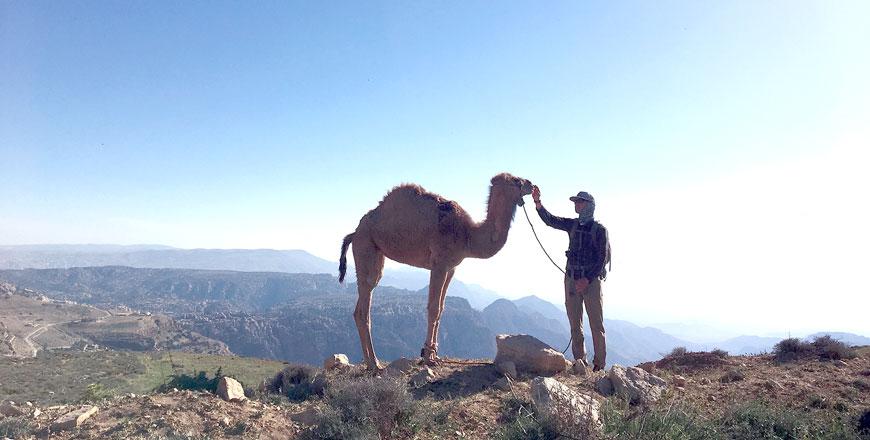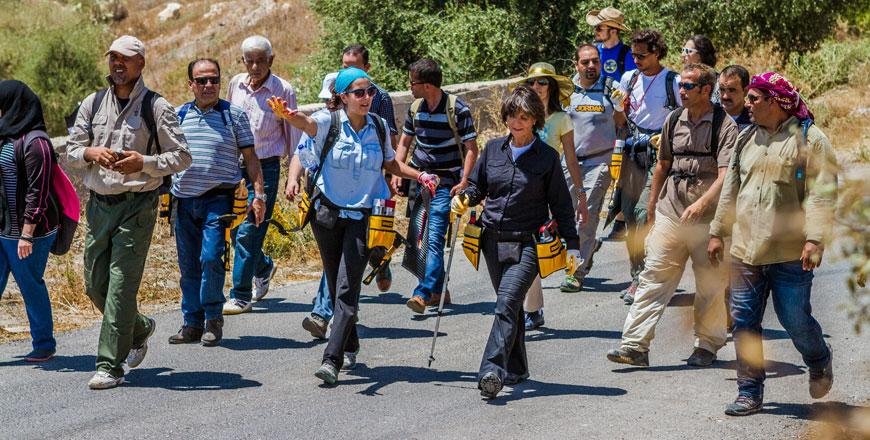You are here
45 days, 645 kilometres: Hiking the new Jordan Trail
By Chicago Tribune (TNS) - Oct 07,2017 - Last updated at Oct 07,2017

A hiker makes friends with a camel near the historic Ottoman village of Dana, Jordan (Chicago Tribune/TNS photo by Andrew Evans)
By Andrew Evans
AQABA, Jordan — On Day 38, the temperature hit 41°C.
Like a slow animal, I slid into a narrow crescent of purple shade, napping beneath a rocky overhang until the sun softened in the late afternoon. The song of a shepherd’s flute echoed off the canyon wall, and the sky glowed an almost digital blue.
By dusk I was hiking once again, shoes in sand, sifting through a kilometre of empty desert as a full white moon rose from behind a broken wall of mountains. The rippled dunes went on forever. Camels hovered on the horizon. The silence was tremendous. Night came with a spread of stars and a cooling breeze that gently ruffled my tent until I was lost in sleep.
Nowhere on Earth have I felt the unbelievable calm that I experienced on the Jordan Trail. This newly mapped 645-kilometre route leads walkers across the up-and-down landscapes and through the staggering history of this impressive little kingdom.
I began my hike in the northern village of Umm Qais, a cobblestone village mentioned in the New Testament — the place where Jesus cast demonic spirits into a herd of swine and sent them tumbling over a cliff.
For the first two weeks of hiking, I could feel my legs getting stronger as I tackled small hills painted green with springtime wheat. Olive groves and lemon trees shaded the path, along with the ancient Corinthian columns of many a Greek ruin. The epic past sits on the surface of Jordan. There were moments on the trail when I found myself sifting through shards of Roman pottery or the Stone Age tools of an even older civilisation, before trudging up the well-worn steps of a crusader castle.
About half the time on the trail, I camped in my own tent, enjoying the quiet wilderness and the pastoral view that I unzipped each morning. In larger towns, I checked into hotels for a hot, soapy shower and a fluffy bed. The rest of the time, I stayed with locals as part of the Jordan Trail’s home-stay programme. The complete trail network includes 52 smaller communities, where participating families host passing hikers for the night. Nothing beats breaking (fresh-baked) bread with a Jordanian family in their own home, all of us gathered together on the floor and dipping into plates of homemade hummus or aromatic rice and chicken roasted over a fire. In time, I found myself speaking more Arabic than I ever thought I could learn, while even the youngest children on the street know enough English to shout out, “Welcome to Jordan!”
The Jordan Trail is not exclusively for the young and athletic. Before this trip, i would never hiked more than five days in a row. I did not undergo any special training for my long-distance trek; I simply started walking, pushing through the first days and feeling my body getting stronger and leaner as the weeks flew past.
Hiking the Jordan Trail
What it is like to hike the newly mapped 645-km Jordan Trail, where walkers can explore the up-and-down landscapes and staggering history of this impressive little kingdom.
Rather than some intense physical feat, the Jordan Trail offers a slow-motion endurance test. The biggest struggle is coping with the daytime heat and taking care of your body by drinking plenty of water, eating good food, resting well and keeping your feet clean, dry and blister-free. (A support van transporting the bulk of our gear met our group each night and provided our tents, if necessary, fresh water refills and food. Licensed tour operators and local hiking companies can be found on the Jordan Trail Association’s website at jordantrail.org/join-a-group.)
The reward is an unforgettable journey through the heart of the Middle East, exploring lesser-known sites such as Mount Nebo, where some say Moses is buried, and Little Petra, an ancient metropolis carved from stone — minus the buses and crowds of nearby Petra. The final stretch leads hikers through whistling sandstone canyons and the cinematic red deserts of Wadi Rum, a recognisable backdrop from movies such as “The Martian” and “Rogue One”.
That last stretch of desert may be the hottest part of the journey, but it also might be the most beautiful section of the trail, where the rocky landscape is splashed with surreal colours, and Bedouin nomads wave you into their woolen tents for tea.
On Day 45, my once-in-a-lifetime journey finished on the glistening shores of the Red Sea, just a few kilometres from the Saudi border, where I stepped over the white waves and collapsed into the warm, shallow saltwater. My elation had less to do with actually completing the full trek — or the fact that I had lost just over 11 kilogrammes along the way — and far more to do with the incomparable joy of truly knowing a country in a way that few tourists ever experience.
As a lifelong traveller who has been to over 100 countries, I know that there is no better way to see a destination than on foot, living among the people who call the place home. That is the allure of the Jordan Trail: to be fully immersed in a timeless culture, forget all about the outside world and follow the sun all the way to the sea.
If you go
Running the length of the country, the Jordan Trail is divided into eight distinct parts, with each section taking four to six days to trek. Our group split up some of the longer daily distances into two-day hikes and added rest days at the end of each section, so that our total thru-hike took 45 days. Since the official opening of the trail earlier this year, a few adventurous solo hikers have completed the journey in fewer than 25 days.
For shorter trips, visitors might consider tackling one or two of the more dramatic sections, such as Umm Qais to Ajloun Castle, Dana to Petra, or Petra to Wadi Rum. Whether travelling as a supported group — highly recommended for inexperienced hikers — or as a go-it-alone solo hiker, a strict “leave no trace” policy is encouraged.
The route is not well marked in places, so a GPS device is essential to stay on course. From a weather and scenery standpoint, February through April is an ideal time to do the hike. For more information on arranging home stays, hiking guides and other support services, contact the Jordan Trail Association at jordantrail.org.
Related Articles
AMMAN — When Dina Aqel, Karma Tabbaa and Duha Fayyad decided to hike the trail connecting Jordan’s north and south, they did not know it wil
AMMAN — The Jordan Trail Association has officially opened the registration for the 2018 Jordan Trail’s Thru-Hike, which will be launched fr
AMMAN — Tourism Minister Lina Annab joined volunteers from the Jordan Trail Association (JTA) on Saturday to place route markers along the f














